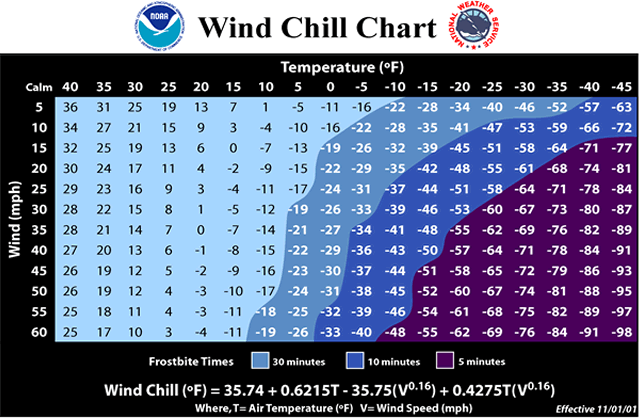Cold Stress Hazards
While not all of the United States experiences extreme cold temperatures, it can present just as much, if not more, of a hazard to people as heat stress. Ensuring that your workers are protected from cold stress environments is essential to sustaining “employment and a place of employment which are free from recognized hazards…”.
Wind Chill

Much like heat stress conditions can be exacerbated by humidity, cold stress conditions can be made more hazardous by wind. The National Weather Service (NWS) has created the wind chill chart shown above that can be used to determine the “real feel” temperature. It’s important to consider the wind chill chart as winds can increase the likelihood of conditions such as hypothermia or frostbite.
Hypothermia
Hypothermia is a dangerous condition that is caused by prolonged exposures to very cold temperatures. When exposed to cold temperatures, your body struggles to retain heat. Over extended periods of time, your body will use up its stored energy leading to lower body temperatures. When the body temperature gets too low, the brain is affected causing the person to think irrationally and struggle with coordinated movement. This makes hypothermia even more dangerous as someone may be experiencing it and not even know it.
If you notice any of the signs/symptoms listed below, in yourself or others, take the persons temperature. If it is below 95° F move to a warmer location and seek medical attention immediately.
Symptoms of hypothermia include Shivering, Exhaustion, Confusion, Memory loss, Slurred Speech, Lack of coordination.
Frostbite
Frostbite is an injury caused by freezing. It leads to a loss of feeling and color in the areas it affects, usually extremities such as the nose, ears, cheeks, chin, fingers, and toes. Frostbite can permanently damage the body, and severe cases can lead to amputation (removing the affected body part). Even worse, a person who has frostbite may not know they have it due to the numbness it causes.
If you notice any of the signs/symptoms listed below, in yourself or others, move to a warmer location and seek medical attention immediately.
Symptoms of frostbite include a white or grayish-yellow skin area, skin that feels unusually firm or waxy, numbness, or redness/pain in any skin area.
Trench Foot
Trench foot, also known as immersion foot, occurs when the feet are wet for long periods of time. It can be quite painful, but it can be prevented and treated. Cold temperatures can exacerbate this condition.
Symptoms of trench foot include a tingling and/or itching sensation, pain, swelling, cold and blotchy skin, numbness, and a prickly or heavy feeling in the foot. The foot may be red, dry, and painful after it becomes warm. Blisters may form, followed by skin and tissue dying and falling off. In severe cases, untreated trench foot can involve the toes, heel, or entire foot.
Cold Stress Mitigation Methods
- Wear appropriate clothing.
- Layer your clothing with loose garments to provide better insulation. Tight clothing reduces blood circulation slowing the circulation of warm blood to the extremities.
- Make sure to protect the ears, face, hands and feet in extremely cold weather.
- Boots should be waterproof and insulated.
- Wear a hat or hardhat liner; it will help to maintain your body temperature. (Headwear reduces the amount of body heat that escapes from your head.)
- Move into warm locations during work breaks; limit the amount of time outside on extremely cold days.
- Drink warm liquids to help raise your core temperature
- Monitor your physical condition and that of your coworkers. If you notice symptoms of any cold stress condition, get them to a warm area and notify a supervisor or medical personnel.
Sources
https://pubmed.ncbi.nlm.nih.gov/25073563/
https://www.cdc.gov/disasters/winter/staysafe/hypothermia.html
https://blogs.cdc.gov/niosh-science-blog/2012/01/20/cold-stress/
